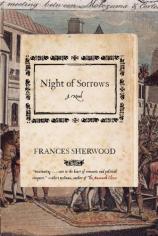Reading Group Guide
Discussion Questions
Night of Sorrows

1. Discuss the storytelling approach used in Night of Sorrows. Did you find the third-person narrative effective or limiting in any way?
2. Compare and contrast Cuy and Malintzín. How do their outlooks on their circumstances differ? To what extent does Cuy envy or resent—or support—Malintzín’s confidence and behavior with the Spaniards?
3. The Franciscan monk, Francisco, is among the most conflicted of the characters, and, as Sherwood explains, in the end he, “unable to identify with the conquistador mentality, chooses the harshest of alternatives.” Do you see Francisco’s death as a suicide? Is there anything in text that warned you this was coming? To what degree does Francisco’s intense piety influence his ultimate choice?
4. While Cortés suffered enormous defeat on the Night of Sorrows, the conquistadores’ intentional military efforts were surpassed by the biological weapons they unintentionally used: agents like smallpox were what most decisively destroyed the populations of the New World. Given that the Spanish ostensibly had Christian missionary goals, too, do you believe that they truly wanted to eliminate the native populations? How do the interactions between Cortés and Francisco in this novel make you feel about the sincerity of Cortés’s efforts at converting the Maya?
5. While the documentation of Cortés and Malintzín’s journey is spotty, Sherwood’s novel is based on real historic events. Consider what was lost because of the destruction wrought by Cortés and others. How convincing is the picture Sherwood draws of Maya civilization? How might today’s world be different, had the ancient cultures of the Americas survived into the present?
6. The European conquest in general, and certainly Cortés’s mission in Mexico, despite his cunning, was often based on erroneous assumptions about the land, the religion, and the nature of the races of peoples encountered. In Sherwood’s telling, what are some of the specific mistakes and misinterpretations Cortés makes? Which of these, in your reading, were personal flaws? And which, on the other hand, do you think reflected the mentality of all Europeans at the time? How convincingly does Sherwood convey the nuances of sixteenth-century racism?
7. History now remembers Hernan Cortés as a ruthless racist who destroyed a culture in a quest for mere material riches. But Sherwood’s portrait of this man is much more nuanced. What positive qualities did you recognize in the Cortés character? Is it possible to sympathize with him in spite of his ultimate goals?
8. Likewise, in Mexico the Spanish term malinchista is used to describe someone who would treason Mexico to outside influences: history remembers primarily Malintzín’s betrayal of her own people to a foreign power. But to what extent is her character also sympathetic? Are her actions understandable given the circumstances? Is she a traitor or a victim?
9. Discuss the role of women in the various societies portrayed. Would Malintzín be a typical example of women of her time and place?
10. Hold a mock trial of Malintzín. She is accused of treason. Have some members of your group act as the defense, others as the prosecution, with one person remaining as a judge or several as a jury. Alternate using quotes from characters in the book as “testimony” from witnesses, and present other information from the novel as evidence. When each side has presented its arguments, have the jury render a verdict.
Night of Sorrows
- Publication Date: April 17, 2007
- Paperback: 432 pages
- Publisher: W. W. Norton & Company
- ISBN-10: 0393329747
- ISBN-13: 9780393329742







